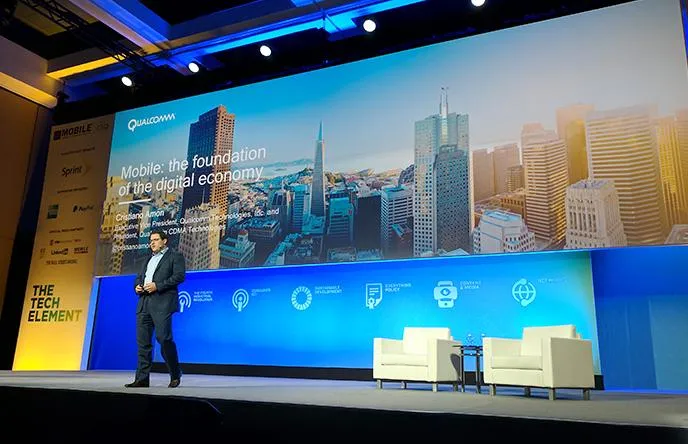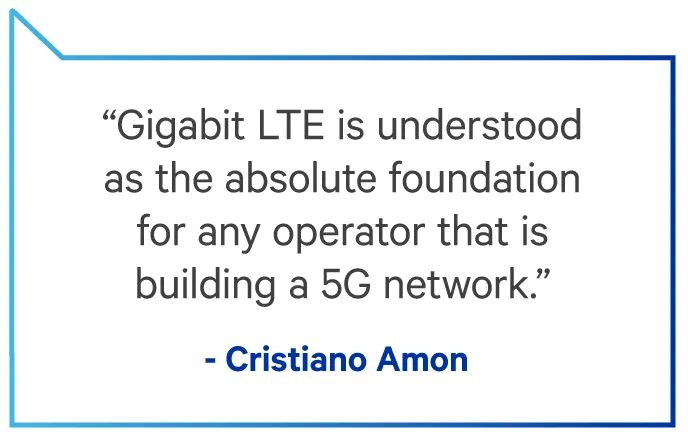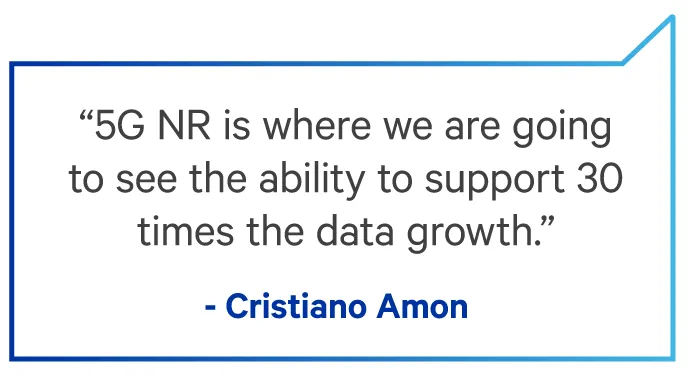MWC Americas: EVP Cristiano Amon discusses Gigabit LTE and 5G in the digital economy

Mobile, the largest technology platform in human history, directly impacts the digital economy. As connectivity evolves and we move toward 5G, an already-expansive mobile ecosystem will extend to new industries, enabling new services and powering new devices. This was the crux of EVP of Qualcomm Technologies, Inc. and President of Qualcomm CDMA Technologies Cristiano Amon’s keynote at MWC Americas.
According to an IHS 5G economic impact study conducted earlier this year, 5G could produce up to $12 trillion in goods and services by 2035. This evolution in connectivity builds on and extends the capabilities of LTE, enhancing mobile broadband to support immersive experiences, lowering latency for mission critical services, and connecting the massive influx of IoT devices to come. The evolution culminates with 5G NR, the global standard that will provide a unified connectivity fabric for almost everything.
Here’s more from Amon’s speech:
5G is on its way, but as we await its arrival, the next step in connectivity is Gigabit LTE. Gigabit LTE will meet the demands of the growing number of mobile connections (7.7 billion and counting) by providing fiber-optic-like cable download speeds without the cable.
Amon was quick to point out the many benefits of Gigabit LTE. For example, devices equipped with Gigabit LTE can support stronger signals and faster speeds, even in crowded places. We’re talking about improved everyday speeds, not just about peak speeds.
And Gigabit LTE-enabled devices won’t suffer the strain of streaming video. Thanks to Category 16 speeds, videos will consume fewer resources than the same quality videos on phones from just a few years ago. Connected apps will also improve, as users gain quicker access to the cloud. Users will be able to stream 360-degree VR videos, with pixel-perfect quality, and millions of songs, even in areas with weak signals.
Amon explained that by increasing the performance of the network for every device, there’s opportunity for faster growth and new services, which directly benefit the digital economy.

Gigabit LTE isn’t a far-off concept. We’re already seeing premium devices with the Qualcomm Snapdragon X16 LTE modem, which is integrated in the Qualcomm Snapdragon 835 mobile platform, achieve Gigabit speeds. And our second-generation Gigabit LTE modem, the Snapdragon X20 LTE modem, can reach Category 18 speeds of up to 1.2 Gbps. The audience at MWC Americas got a taste of these lightning-fast speeds when we demonstrated Gigabit LTE using Licensed Assisted Access with our partners AT&T and Ericsson.
This isn’t an isolated event. “Gigabit LTE is understood as the absolute foundation for any operator that is building a 5G network,” Amon said. Already, 38 operators in 23 countries are deploying and trialing Gigabit LTE. These operators serve over 1.2 billion LTE connections, demonstrating just how extensive of a technological foundation Gigabit LTE will be, and how it’ll be a requirement for 5G deployment.

Mobile data is predicted to increase 30X between 2014 and 2020, driven by the consumers’ insatiable demand for immediate access to the internet. This growing desire for more bandwidth and faster data speeds will impact mobile networks and require new technologies with access to mmWave and sub-6-GHz spectrum.
We’re already working on a few of these solutions. For instance, we’ve found that operators can use their existing infrastructure to achieve excellent outdoor mmWave coverage. This, in turn, frees up sub-6-GHz spectrum for indoor use. Just this week, we announced a 5G NR mmWave prototype that will accelerate mobile deployment for smartphones. With mmWave and sub-6-GHz technologies, we’ll soon be able to stretch our supply of spectrum to meet the growing demand.

“The potential to build the 5G infrastructure and unleash the potential of enhanced mobile broadband is right in front of us,” stated Amon. We’ll start to see 5G NR deployment in 2019, enabling a unifying fabric for connected devices. To support this timeline, Qualcomm is currently beginning 5G trials with operators and OEMs around the world, which includes our recently announced 5G interoperability and over-the-air field trials with Nokia.
In the meantime, we’ll continue to push LTE forward to ensure that we have a strong foundation for the new services that will accelerate the digital economy once 5G rolls out.
"The best years of the mobile industry are yet to come," Amon said. "We're just at the beginning."
Authored by The OnQ Team







